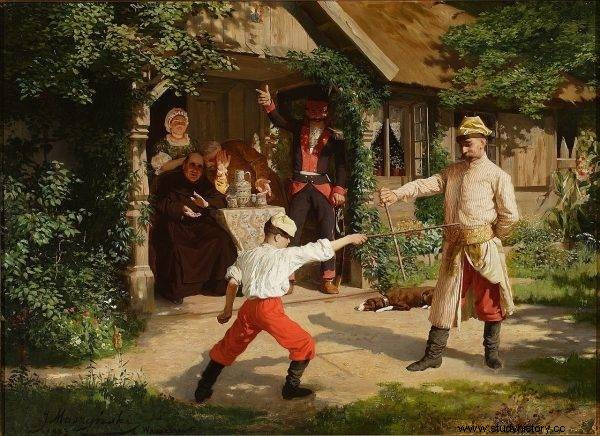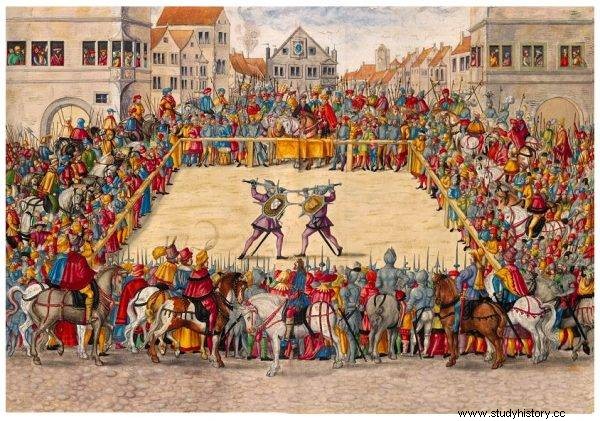Hardly anyone knows, but Poles used to have ... their own martial art. It is about the so-called Short sticks, which were very popular both among students and "palestrant servants".
What was stalking anyway? Well, it was a kind of stick fencing. In this fight, sticks ranging in length from 70 to 90 cm were used, the ends of which were protected against excessive injuries. The sticks were wrapped with cloth or simply straw. The exercises in such a fight were to prepare the swordsman for the later efficient use of the saber, which is reported, for example, in the 19th century Universal Encyclopedia . It defines the finger as a stick used to prop up while walking, usually knotty, made of hard, deciduous trees immediately after adding that fingers were called thinner sticks, of one measure used by schoolchildren to make sabers. For the one who showed himself to be the most skillful in shin pads, was then given a saber to show off with it .
In Poland it was a popular form of recreation, especially among the nobility. In older sources (like the one by Jędrzej Kitowicz, referring to the times when August III ruled in Poland) it is mentioned that this method was very much needed for a peculiarly noble state, as it made the youth use a saber . Jan Duklan Ochocki, the chamberlain of another king of Poland, Stanisław August Poniatowski, mentioned his participation in the stalking fight at a later stage in Polish history. At the same time, his report informs us that little boys were already taught to "handle" sticks: I was not more than seven years old, when I was riding a horse with a carab (...) with a weapon, beat with a stick with a selvedge wound with Jaś, the son of a staroste .
Whether it was recreationally or before classes in schools, students often fought with sticks, and fought to the point of death . There were, however, some rules:you were not allowed to hit the head, face or side. At the same time, participation in the fight was a matter of honor. If any of the students refused to fight the other, he had to reckon with insults throughout the school, and even with physical aggression . The more experienced ones themselves became teachers of this form of dueling. Interestingly, even the "younger professors", both Jesuits and Piarists, took part in these fights.
It is also possible to find mentions of palcatach earlier than the reign of Augustus III, if of course you believe the author. Here is the novelist Henryk Rzewuski, describing the biography of Adam Śmigielski, the starost of Gniezno during the reign of Stanisław Leszczyński, he quarrels, and he himself was able to keep his word with such steadfastness . So he chose, as his opponents, the officers of the court militia the voivode and his courtiers, because with them such a game could not turn into a quarrel.
In general, stalking fights were known in Europe in the 17th and 18th centuries. For example, at the end of the 18th century, the German educator Jan Krzysztof Fryderyk GutsMuths in his textbook Gymnastics for young people he placed, among others fencing, advising younger children to fight with sticks. Interestingly, the sticks were not viewed favorably everywhere. For example, in the 15th century, Polish schools with a statute issued by the bishop of Chełmno allowed to play football, while sticks were forbidden. Other prohibited activities include rowing and swimming in the Vistula. On the other hand, as early as in the 18th century, stumbling into short sticks was included in the program for the development of the physical condition of young people prepared by the National Education Commission.
Fingers in distant (and less distant) history
Traces of information about similar battles can also be found in relation to earlier periods in the history of our continent. In another volume of the Encyclopedia mentioned above there is a mention that the two sons of Eaka (aka Ajakos, king of the Myrmidons), Peleus and Telamon, killed their brother Fokus by accident or intentionally while playing clubs, for which they were sentenced to exile by their father.
In turn, in a source from the end of the 1920s, we find a drawing showing two Egyptians fighting for objects held in one hand, resembling sticks with pads on the other hand. The caption of this figure states that it is based on sources (or exhibits?) From the British Museum. But can it be emphatically said that this drawing in any way represents the ancestor of the fingers, and did these ancient Egyptian battles inspire later such battles in Europe? Can it be unequivocally confirmed at all?

Whether it was recreational or before school, students often fought with sticks, and fought to the point of death.
Let's jump several centuries forward, to the Middle Ages. During these times, knightly tournaments were extremely popular. However, other duels, some of pagan origins, also took place during these years. These were court duels, being one of the characters of the so-called God's judgments. What was that about? Well, in deciding whether to blame or innocent, you relied on God's will. It was believed that in the duel of the accuser with the accused, an innocent man would easily prove his innocence with God's help and defeat his opponent .
Importantly, these duels were attended by representatives of all social classes and both genders, who could fight against each other. Women could count on a certain - as we would call it today - handicap, because the men were fighting in the pit, which reached their waist. But what does this have to do with fingers? Well, during the fights, representatives of the non-noble people used sticks instead of a sword. It is therefore speculated that in some way these fights may have contributed to the stalking duels.
Shoe fighting forms in Polish history
Remember the Jesuits mentioned above? The same Henryk Rzewuski in another of his works, referring to the Polish reality of the 18th century, states that one of the games in schools run by the Jesuits was the stalking fight. But we also learn about another form of it. Well, behind the monastery there was a special, spacious place where a kind of "finger battles" took place. The students were divided into two groups (usually Poles and Turks, lots were drawn in this matter), and their task was to defend their own "rolling stock" and conquer the enemy's camp . And this is how we find out that the sticks also had a "group" form, in which there were battles between two "armies", sometimes commanded by elected marshals.
However, these are still not all forms of pole fights. Palestrant servants, as they were once called, from tribunal castles that were not allowed to carry arms, had their tradition here. In front of the town hall they formed a circle in which sticks were beaten, which, according to the fighters, older or younger, were sometimes thinner and thicker, common bits or oaks, the thinnest for young boys, like a finger, the thickest for the mustache, like cost or peasant truncheon .

In the Middle Ages, there were also other duels, partly of pagan origin. These were court duels, being one of the characters of the so-called God's judgments.
The best in these struggles was appointed a marshal, another deputy marshal, another an instigator, and the fourth a vice instigator. Then the entire "crowd" headed for the Jews, who believed that they were obliged to entertain the new arrivals with a treat and give them gifts. If they failed to do so, they risked being in the wheel themselves the next time and being bruised. Oh, such "voluntary". It did not take place only in land and town courts, there was no custom of receiving treaties.
Importantly, you could take part in these fights even accidentally, only by passing by. Even if you were of a higher order, you could be pulled into the wheel by force. You had a choice in this situation:refuse to fight and get stick on the head and buy yourself, then you were no longer dragged into the wheel, but without the honor of kinship, with the addition of an insulting title or to fight and then getting hit was an honor, and such a delinquent became a "guild colleague" gathered and, if he wished, he could participate in these fights of his own free will.
Over time, this form of education of young people or recreation disappeared (to which the partitions certainly contributed), remaining only a subject of analysis for experts in the subject and those interested in the broadly understood history of fencing. And it is worth remembering, perhaps perversely according to the principle "you praise others, you do not know yours" when we think about foreign martial arts, for example Far Eastern kendo or other similar forms.
